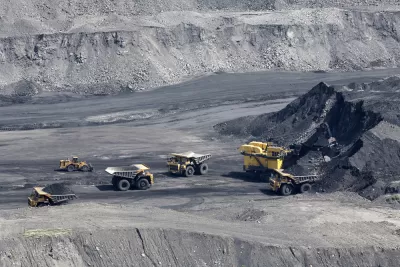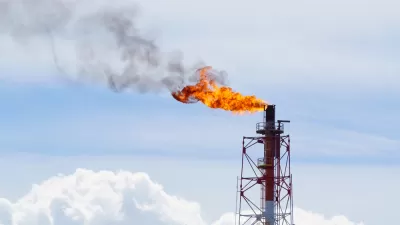Flanked by coal miners, President Trump signed an executive order on Tuesday that begins the roll back of his predecessor's signature environmental rule, the Clean Power Plan, and other environmental regulations to facilitate energy production.

With the signing of the executive order on March 28, President Trump was following through with promises he had made as candidate Trump to implement an "America-First" energy plan.
A new era now commences in the White House on energy. Whereas the focus in the Obama administration was to reduce greenhouse gas emissions and promote renewable energy, the priority in the Trump administration is to revive jobs in the fossil fuel sector.
"My administration is putting an end to the war on coal," stated President Trump at the signing ceremony held on March 28 in the Environmental Protection Agency Headquarters. "We're going to have clean coal -- really clean coal."
The executive order, "Promoting Energy Independence and Economic Growth," does just the opposite. By rolling back the Clean Power Plan rule, energy utilities have no reason to burn so-called clean coal, a generic term that entails capture and storage of carbon emissions, an expensive procedure that many experts suggest may be infeasible from an economic perspective.
"Basically, you know what this is, fellows, you know what it says?" the president asked the coal miners as he prepared to sign the executive order (see video below).
"You're going back to work!" he answered to much applause.
"U.S. coal jobs, which number about 75,000, have been declining for decades," report Juliet Eilperin and Brady Dennis for The Washington Post. "A senior administration official who briefed reporters Monday evening did not predict how many jobs might be spurred by this shift in policy." When White House press secretary Sean Spicer was asked at a press briefing Tuesday afternoon how many jobs would result from the executive order, he too was unable to provide a figure.
In addition to initiating the procedures to roll back the clean power plan rule, the executive order:
- "Directs departments and agencies to immediately review existing regulations that potentially burden the development or use of domestically produced energy resources...."
- Directs Secretary of the Interior Ryan Zinke to lift the moratorium on Federal land coal leasing.
"Some of the measures could take years to implement and are unlikely to alter broader economic trends that are shifting the nation’s electricity mix from coal-fired generation to natural gas and renewables," note Eilperin and Dennis.
Rolling back Clean Power Plan not so simple
The president does not have the legal authority to roll back the Clean Power Plan, stated a critic of the rule. Eilperin and Dennis lay out the procedure to rescind the 2015 rule.
The agency must first get permission from the U.S. Court of Appeals for the D.C. Circuit, where the rule is tied up in litigation, to revisit the matter. Then, agency officials will have to justify reaching the opposite conclusion of the Obama EPA, which argued it was technically feasible and legally warranted to reduce carbon pollution by about one-third by 2030, compared with 2005 levels.
Still, regulatory relief could make some coal firms, nearly 50 of which have filed for bankruptcy since 2012, somewhat more economically viable. Some of the sector’s biggest companies — including Arch Coal, Peabody Energy and Alpha Natural Resources — are just now emerging from bankruptcy protection.
Nuclear power plants most at-risk if carbon regulations eased
"Ethan Zindler, head of U.S. research at Bloomberg New Energy Finance, said in an email that solar and wind are competitive with coal in some parts of the country and that natural gas ranks as the lowest-cost source of electricity generation overall," write Eilperin and Dennis. That was also the finding of a new analysis from Moody's Investor Services that shows that the falling price of wind energy will hasten the demise of older coal-burning power plants in the Midwest.
The sector that could suffer the greatest hit from the elimination of the Clean Power Plan is nuclear energy, which provides about a fifth of U.S. businesses’ and households’ power.
“Many of the 100 or so U.S. plants are aging, and approximately a third are economically uncompetitive today,” Zindler said. Without stricter federal emissions limits, he added, “there may be little to stop the retirement of these plants in coming years and their replacement with a combination of gas, wind and solar.”
===============================================================================
Earlier in Planetizen:
- Trump Targets Obama's Signature Environmental Rule, the Clean Power Plan, February 23, 2017
- Clean Power Plan Showdown in U.S. Appeals Court on Tuesday, September 28, 2016: The Obama Administration's most powerful environmental initiative, the Clean Power Plan, was put on hold by the Supreme Court last February.
FULL STORY: Trump moves decisively to wipe out Obama’s climate-change record

Alabama: Trump Terminates Settlements for Black Communities Harmed By Raw Sewage
Trump deemed the landmark civil rights agreement “illegal DEI and environmental justice policy.”

Planetizen Federal Action Tracker
A weekly monitor of how Trump’s orders and actions are impacting planners and planning in America.

The 120 Year Old Tiny Home Villages That Sheltered San Francisco’s Earthquake Refugees
More than a century ago, San Francisco mobilized to house thousands of residents displaced by the 1906 earthquake. Could their strategy offer a model for the present?

Ken Jennings Launches Transit Web Series
The Jeopardy champ wants you to ride public transit.

BLM To Rescind Public Lands Rule
The change will downgrade conservation, once again putting federal land at risk for mining and other extractive uses.

Indy Neighborhood Group Builds Temporary Multi-Use Path
Community members, aided in part by funding from the city, repurposed a vehicle lane to create a protected bike and pedestrian path for the summer season.
Urban Design for Planners 1: Software Tools
This six-course series explores essential urban design concepts using open source software and equips planners with the tools they need to participate fully in the urban design process.
Planning for Universal Design
Learn the tools for implementing Universal Design in planning regulations.
Clanton & Associates, Inc.
Jessamine County Fiscal Court
Institute for Housing and Urban Development Studies (IHS)
City of Grandview
Harvard GSD Executive Education
Toledo-Lucas County Plan Commissions
Salt Lake City
NYU Wagner Graduate School of Public Service




























